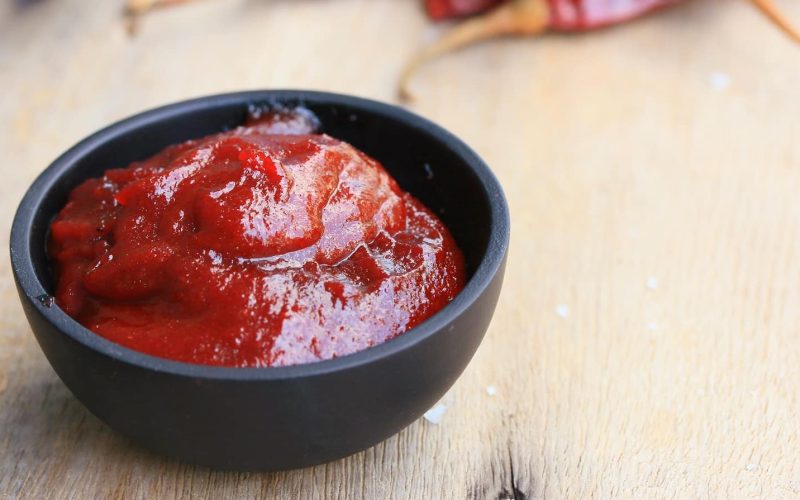Gochujang is a key ingredient in many Korean dishes, but sometimes it’s hard to find, or you don’t have any on hand.
Luckily, several great substitutes for Gochujang can be used in its place to recreate the same flavor and texture.
In this ultimate guide to the best substitutes for gochujang, we will provide you with a list of the best alternatives that can be used to make delicious Korean meals.
Keep reading to learn more about these alternative ingredients and how to use them. But first, learn a little about Gochujang itself!
What is Gochujang?
Gochujang is a popular condiment and cooking ingredient used in Korean cuisine.
It is a thick, spicy red paste made from fermented chili peppers, glutinous rice, soybeans, and salt.
The unique combination of sweet, spicy, and salty flavors makes gochujang an essential component of many traditional Korean dishes.
Furthermore, its deep red color also makes it a visually appealing addition to food. Gochujang can be used to add flavor to soups, stews, marinades, and dipping sauces.
Now, let’s dive into the list of the best substitutes for Gochajang!
Substitutes for Gochujang
1. DIY Miso-Based Sauce
Miso is a fermented soybean paste commonly used in Japanese cuisine, but it can also be used to create a gochujang-like sauce.
To make this miso-based sauce, you’ll need to combine miso paste, garlic, soy sauce, sesame oil, rice vinegar, and a sweetener of your choice (such as honey or sugar).
You can adjust the sweetness, saltiness, and acidity levels to your taste preference.
The resulting sauce will have a rich umami flavor and is perfect for marinating meats, vegetables, and tofu.
This sauce can be stored in an airtight container for up to two weeks in the refrigerator.
When you’re ready to use it, heat it on the stovetop until warmed through, and you’re ready to enjoy.
Also, it can be used as a condiment or even added to soups and stir-fries for a flavorful twist.
Whichever way you choose to use it, this DIY miso-based sauce is sure to give your dishes that gochujang kick you crave.
This starts off our list of the best substitutes for Gochujang.
2. Ssamjang
Coming in second on this list of delectable substitutes for Gochujang is Ssamjang, a popular condiment in Korean cuisine.
It comprises a combination of gochujang, doenjang (soybean paste), sesame oil, garlic, and onion.
The end result is a thick, spicy, and savory paste that is used for dipping or as a condiment for grilled meat.
Meanwhile, this condiment has a subtle sweetness to it and can be used in place of gochujang. It won’t be as spicy but will still provide that savory kick you need.
You can buy it pre-made or make your own using ingredients from your local Asian grocery store.
In conclusion, ssamjang makes an excellent substitute for gochujang if you don’t have the latter on hand. It may not be as spicy, but the savory flavor will give you the flavor you need.
Making your own ssamjang at home can be a fun and rewarding experience, so why not give it a try?
3. Tomato Paste
Tomato paste is one of the excellent substitutes for gochujang. It’s a thick, concentrated paste made from cooked tomatoes that have been strained from seeds and skin.
Tomato paste is easy to find in any grocery store and can be used to add a rich and savory flavor to various dishes.
When using tomato paste as a substitute for gochujang, it’s important to adjust the seasoning levels since it has much less heat than gochujang.
You can also mix some red pepper flakes into the tomato paste to give it an extra kick of heat.
To give a unique flavor and texture, tomato paste also works well when mixed with other sauces or condiments, such as miso or soy sauce.
4. Harissa Paste
One of the amazing substitutes for Gochujang, Harissa paste, is a spicy condiment made from chili peppers, garlic, oil, and spices.
It is usually made with red chilies, such as Aleppo, but it can also be made with other types of chilies, such as cayenne or jalapeno.
It has a unique flavor that adds a kick to any dish. It is also often used as a marinade or in sauces.
Harissa paste can be an excellent substitute for gochujang, especially if you are looking for something with extra heat.
Just be sure to adjust the amount you use depending on the heat level of the chili paste you use.
5. Thai Chili Paste
Thai chili paste is a great substitute for gochujang. This condiment blends chili peppers, garlic, and other spices.
It is an excellent way to add heat and flavor to any dish. The paste is also known for its thick consistency and deep red color.
Depending on the brand and type, Thai chili paste can range from mild to spicy.
It is a great option for those looking to switch up their traditional gochujang flavors without sacrificing too much heat.
Thai chili paste can be used in various recipes, including stir-fries, curries, sauces, marinades, and soups.
Moreso, it is one of the best substitutes for Gochujang that can also be added to noodles, rice dishes, sandwiches, and more.
To make the perfect Thai chili paste substitute for gochujang, try combining it with sesame oil and soy sauce.
This combination will give your dish a deep and complex flavor that will transport you straight to the streets of Thailand.
6. Sambal Oelek
Sambal oelek is a type of Indonesian chili paste that can be used as an alternative to gochujang.
It is made from ground chilies, vinegar, garlic, and salt and has a more intense heat and slightly sweet taste than gochujang.
It works well in dishes that require more intense heat than gochujang and can be used as a condiment for noodle dishes, stir-fries, marinades, and even sandwiches.
Sambal oelek adds a nice spicy kick to sauces, stews, and curries. As with any other substitutes for Gochujang, it should be added in small amounts until the desired flavor is achieved.
7. Sriracha
Sriracha is one of the most popular and widely-used sauces in the world, and it can make an excellent substitute for gochujang.
This chili-garlic sauce has a spicy kick and sweet notes that balance each other out. Sriracha is widely available in supermarkets, making it an easy alternative to gochujang.
The key difference between sriracha and gochujang is that sriracha is typically thinner in consistency.
You can use a bit more sriracha than gochujang to get the desired level of spiciness and heat.
If you’re looking for easy substitutes for gochujang, try using sriracha. Just make sure to adjust the amount used to suit your taste.
You can also mix sriracha and gochujang together if you want to create a unique flavor profile that’s slightly different from either one.
This combination will give you some of the sweetness of gochujang and the extra kick of sriracha.
You can use this blend in various dishes, from marinades and dressings to stir-fries and soups.
It’s a great way to add complexity and depth of flavor to a dish without going overboard on spiciness.
Try experimenting with different ratios of the two sauces to find the blend that’s perfect for you.
We aren’t done with this list of different substitutes for Gochujang! Continue reading.
8. Red Pepper Flakes
Red pepper flakes, or gochugaru, can be used as an excellent substitute for gochujang.
It is not quite as sweet as gochujang, but it can still provide a good level of heat and flavor.
Red pepper flakes are a great option for those looking for a simple and easy-to-find substitute for gochujang.
To use red pepper flakes as a substitute, you must make a paste. This is done by combining equal parts of red pepper flakes with an equal amount of water.
Once the mixture is combined, you can add additional ingredients such as garlic, onion, sugar, and vinegar to taste.
This can then be added to any dish that calls for gochujang, and you’ll get similar flavors with a good amount of heat. This winds up our list of the various substitutes for Gochujang!
How is Gochujang Made Traditionally?
Traditional gochujang is fermented in an earthenware jar outside (jangdok, hangari, or onggi).
However, because of commercial gochujang manufacture (since the early 1970s), most Koreans today buy gochujang at grocery shops or marketplaces. Making your own gochujang is a surprisingly simple fermentation endeavor.
However, you must first locate the ingredients and a suitable container for fermentation.
Fermentation should last at least two months, although prolonged fermentation results in a more pronounced umami flavor.
Conclusion
Are you looking for a way to add some heat and umami to your dishes without using gochujang?
If so, you’ve come to the right place! The article above provided you with some of the best substitutes for gochujang that can be used in any recipe.
We also looked at the different types of substitutes for gochujang available and how to choose the best one for your dish.
So, you can now get started on finding the perfect substitutes for gochujang for yourself!








